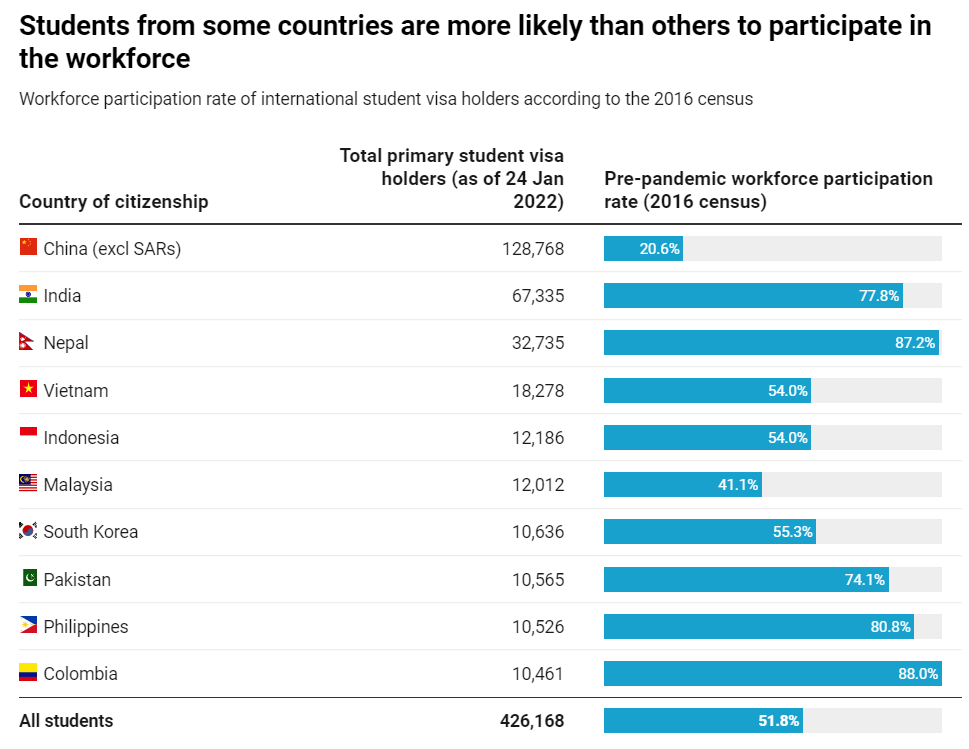International education is said to be a lucrative export.
Universities Australia Chief Executive Catriona Jackson recently boasted that “education is our largest services export and the biggest product we don’t source from the ground”.
“The export income our universities help generate pays for essential services and underpins a higher standard of living for all Australians, regardless of where they live”.
The reality could not be further from the truth.
The conditions of entry for international students requires them to have the financial capacity to support themselves for a year.
The Department of Home Affairs website specifically states that students must have:
- Sufficient funds to cover travel costs and 12 months of living and tuition fees for students and their accompanying family members, and school costs for any school aged dependants; or
- Evidence that the student’s spouse or parents are willing to support them and have an annual income of at least AUD 60,000 for single students, or at least AUD 70,000 for students accompanied by family members.
In reality, most students come from poor nations with little financial resources, and they must work to support their living expenses and course fees.
A significant number of ‘students’ also travel to Australia on phony courses with the intent of working and residing here.
International education is not an export in either situation because most students pay for their tuition and living expenses with money earned while working in Australia.
Nonetheless, the ABS, Treasury, the education sector, and the media mistakenly designate such living and course fee expenditures as exports.
The ABS methodology explicitly explains how international student income is wrongly counted as an export, even if it is earned in Australia.
“The concept of residency is vital for international trade statistics – including for international trade in services”, the ABS methodology states.
“Residency is not based on location, nationality or legal status (e.g. citizenship). Instead, residency is defined by ‘the centre of predominant economic interest’ of an organisation or individual”.
“The only exception to this residency guideline is for international students, who are deemed residents of their home economies for the duration of their study”.
Thus, any income earned in Australia by international students is wrongly counted as an export by the ABS.
In turn, the whole edifice that “education is our largest services export and the biggest product we don’t source from the ground” is false, given most students pay for their studies and living costs by working in Australia (Chinese students are the main exception):

The international education export myth was debunked in April when the Herald-Sun reported that demand for free food services and food banks has risen across Melbourne’s universities, with international students accounting for 85% of this demand.
According to the research, the majority (85%) of students using these services are international, and three quarters are undergraduate.
A subsequent Monash University report obtained exclusively by Guardian Australia last month likewise showed that international students in Australia are becoming homeless and hungry, necessitating support from taxpayers.
“There are 182,000 international students currently living in Melbourne, representing almost 40% of Victoria’s entire university population”, The Guardian reported.
“Almost half those surveyed experienced food insecurity – triple the rate of the wider population”.
“Co-author of the report Dr Beatriz Gallo Cordoba said she was shocked by how “at the brink” of hardship the interviewees were”.
“She said international students needed more support, including with food relief, financial support, vouchers or scholarships”.
Over the weekend, former international student Daksh Tyagi explained in The SMH how he arrived in Australia with little money and then took on paid employment to pay for his studies and living expenses.
“I had arrived in Melbourne hoping that the money I had brought might last until I found a job and a place to live”….
“More concerning, however, was that the money it had taken my father four months to earn was about to run out within weeks”.
“I only had to step out of the house, and the city had a knife to my throat and a hand in my pocket”.
“My focus had shifted to first finding work and accommodation. Formal education barely made the syllabus”.
Does this sound like a great export? Or a broke and hungry import? Stories like Daksh Tyagi’s are commonplace.
While we sympathise with their struggle, what is the point of having “exports” of international education who are more correctly characterised as working poor?
Most students survive by vying for jobs against younger Australians and many rely on charity and assistance to pay their living expenses.
This is a race to the bottom for both international students and unemployed locals alike.
The truth is that international education was never a genuine “export”.
They are part of the Ponzi scheme of immigration, which is designed to drive up asset prices while depressing wages, undermining living standards for younger and working people.
When international students become a drain on charitable services, the nation’s economic and human value begins to decline.
Rather than diverting scarce taxpayer and charitable resources to international students, financial requirements for admission should be drastically lifted and enforced, and work rights should be limited.
Requiring international students to pay for their course fees and living expenses with money earned in their home countries would turn them into a genuine export and increase their economic value to Australia.

